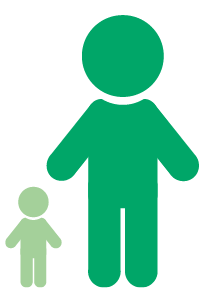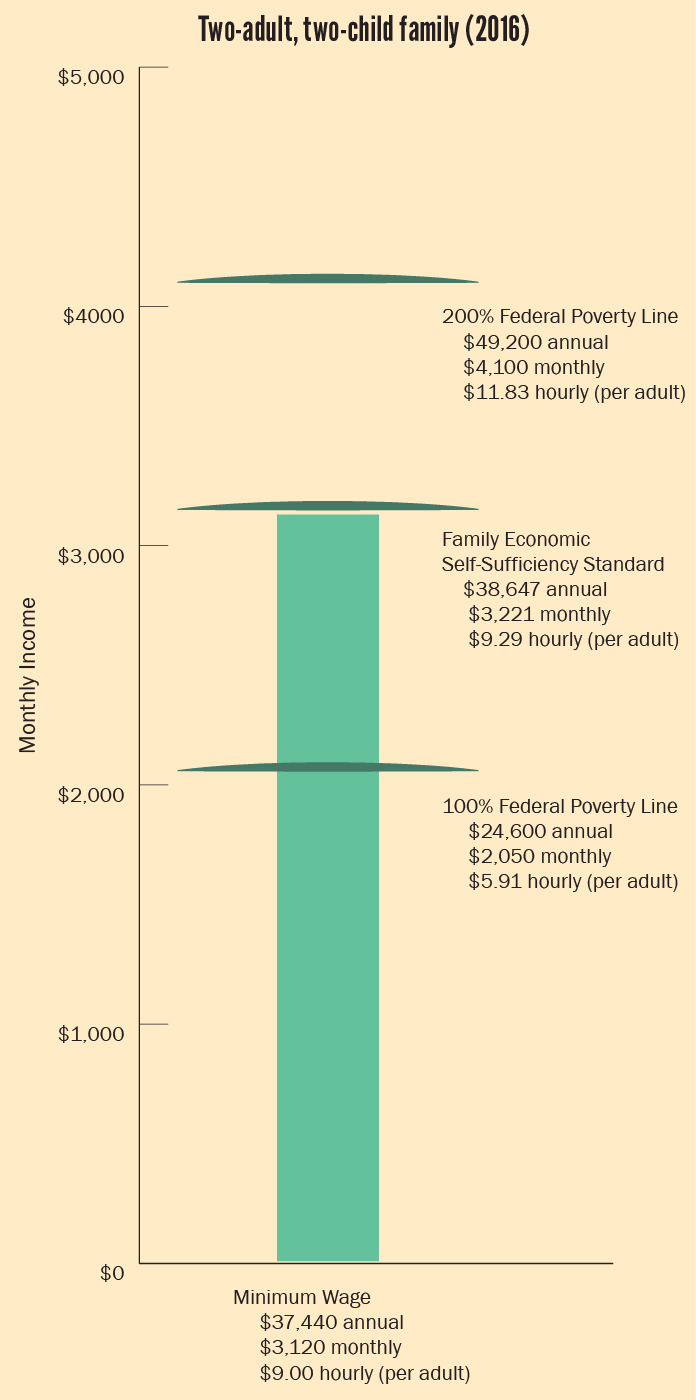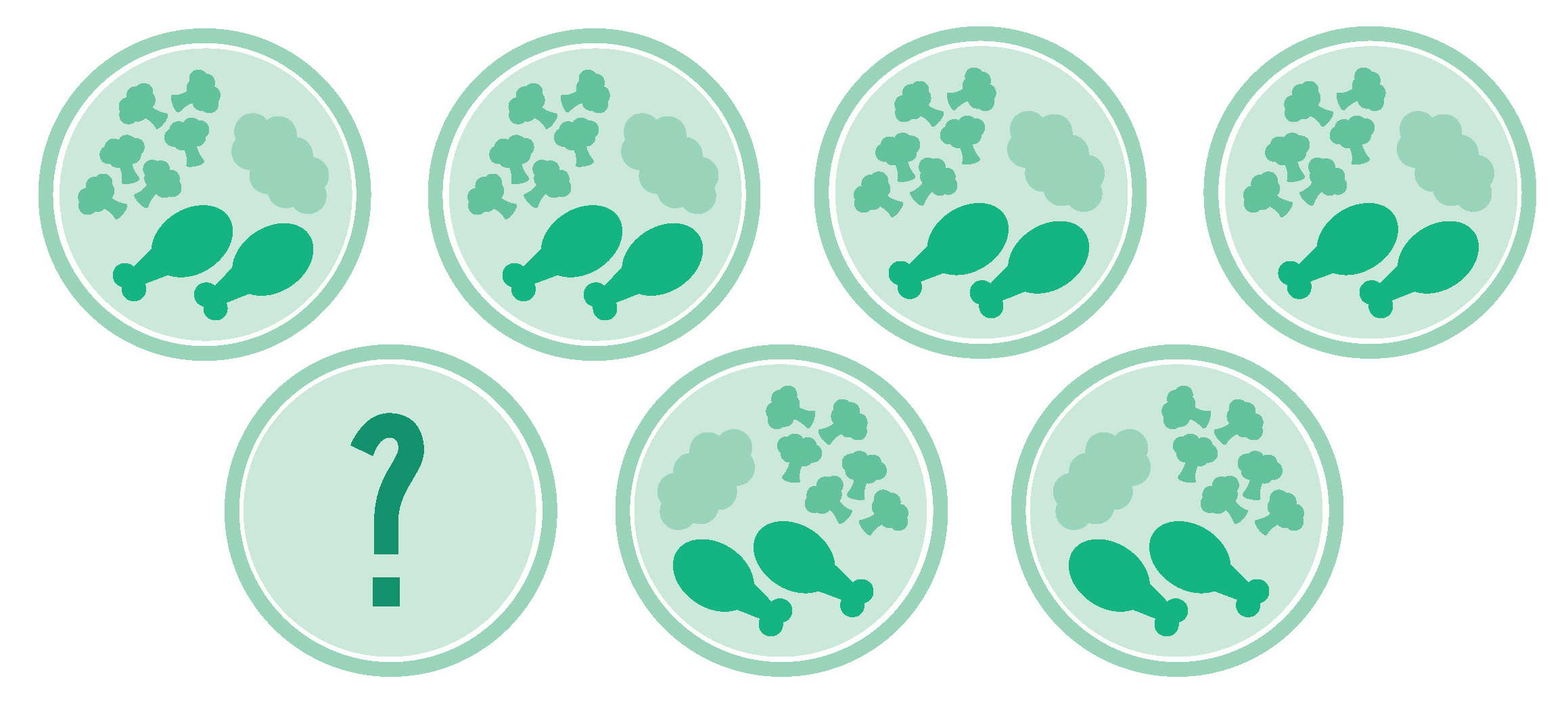
White families’ median income is 1.7x higher than the median income of families of color.1
20.1% of Nebraska households are underbanked and may be forced to rely on costly financial services to meet their basic needs.2
2. Assets and Opportunity Nebraska State Data, 2016.
Our values
Our children, communities, and state are stronger when all of Nebraska’s families are able to participate fully in the workforce and establish financial security.
Achieving economic stability occurs when parents have the education, skills, and opportunity to access work that pays a living wage. In turn, parents who are economically stable can provide their children housing, child care, health care, food, and transportation.
Public assistance provides a vital safety net for families who are unable to provide these necessities on their own. Well-structured public assistance programs gradually reduce assistance while supporting families moving toward financial independence.
Poverty
43.4%
of children living in single-mother households are in poverty.1
21.3%
of children living in single-father households are in poverty.1
8.2%
of children living in married-couple households are in poverty.1
19.1%
of children living with a grandparent, without a parent present are in poverty.2
2. U.S. Census 2016 American Community Survey 1-year estimates, Table S1001.
In the United States, there is an ongoing relationship between race and ethnicity and poverty, with people of color experiencing higher rates of poverty. Poverty rates in Nebraska also continue to reveal significant disparities based on race and ethnicity. These disparities grew out of a history of systemic barriers to opportunity for people of color that still have a presence in our society and institutions today. We need to continue working to address these barriers in order to ensure that all children have the best opportunity to succeed.
Nebraska poverty (2007-2016)
- Percent of Children in Poverty
- Percent of Families in Poverty
- Percent of All Persons in Poverty
- Percent of Children in Poverty
- Percent of Families in Poverty
- Percent of All Persons in Poverty
| Nebraska poverty rates (2016) | |
| Poverty rate for children | 14.2% |
| Poverty rate for families | 12.0% |
| Poverty rate for all persons | 11.4% |
| Nebraska poverty by race/ethnicity (2015) | ||
| Race/ethnicity | Percent of children in poverty (17 and under) | Percent of population in poverty |
| American Indian/Alaska Native | 49.9% | 40.5% |
| Asian/Pacific Islander | 23.1% | 19.0% |
| Black/African American | 42.8% | 30.9% |
| Hispanic | 32.2% | 25.7% |
| Multiracial | 23.3% | 21.7% |
| Other/Unknown | 29.3% | 23.9% |
| White, non-Hispanic | 10.7% | 9.3% |
Making Ends Meet
Making ends meet
Nebraskans pride themselves on being hard-working people. In 2016, 77.9% of children in our state had all available parents in the workforce.1 Unfortunately, having high labor-force participation doesn’t always translate into family economic stability.
The chart at right illustrates the gap between low-wage earnings and the amount needed to provide for a two-parent family with two children. It assumes that both parents work full-time (40 hours a week), year round (52 weeks per year). That means no vacation, no sick time, just work.
Minimum wage in Nebraska is $9.00 an hour.2 If both parents work at minimum wage, their monthly income will be $3,120. This puts them above the federal poverty level of $2,050.
The federal poverty level doesn’t describe what it takes for working families to make ends meet. For that we turn to the Family Economic Self-Sufficiency Standard (FESS). The FESS uses average costs, like fair median rent or the average price of a basic menu of food, to calculate what a family needs to earn to meet its basic needs without any form of private or public assistance. It does not include luxuries like dining out or saving for the future.
For a two-parent, two-child family of any age, the FESS for Nebraska is $3,221 a month.3 That requires an hourly wage of $9.29 per parent.
2. United States Department of Labor, “Minimum Wage Laws in the States – January 1, 2016,” www.dol.gov.
3. FESS was calculated using an average of 2010 figures for a two-adult, two-child family, adjusted for 2017 inflation. Data used to calculate information is courtesy of Nebraska Appleseed Center for Law in the Public Interest. For more information, please see the Family Bottom Line Report: www.voicesforchildren.com/familybottomline.

2017 Federal Poverty Level Guidelines
|
Program Eligibility
|
|
Free Child Care Subsidy (non-ADC), SNAP
|
WIC Reduced Price Meals, Transitional Child Care Subsidy
|
CHIP (Kids Connection)
|
ACA Exchange Tax Credits
|
|||
|
Family size
|
100%
|
130%
|
150%
|
185%
|
218%
|
300%
|
400%
|
|
| 1 | $12,060 | $15,678 | $18,090 | $22,311 | $26,291 | $36,180 | $48,240 | |
| 2 | $16,240 | $21,112 | $24,360 | $30,044 | $35,403 | $48,720 | $64,960 | |
| 3 | $20,420 | $26,546 | $30,630 | $37,777 | $44,516 | $61,260 | $81,680 | |
| 4 | $24,600 | $31,980 | $36,900 | $45,510 | $53,628 | $73,800 | $98,400 | |
| 5 | $28,780 | $37,414 | $43,170 | $53,243 | $62,740 | $86,340 | $115,120 | |
| 6 | $32,960 | $42,848 | $49,440 | $60,976 | $71,853 | $98,880 | $131,840 | |
| 7 | $37,140 | $48,282 | $55,710 | $68,7095 | $80,965 | $111,420 | $148,560 | |
| 8 | $41,320 | $53,716 | $61,980 | $76,442 | $90,078 | $123,960 | $165,280 |
*For families with more than 8 people, add $4,180 for each additional member.
Aid to Dependent Children
Aid to Dependent Children (ADC) (SFY 2016)
ADC recipients by age
- Ages 19+ (22.8%)
- Ages 15-18 (8.7%)
- Ages 6-14 (35.4%)
- Ages 0-5 (33.0%)
- Ages 19+ (22.8%)
- Ages 15-18 (8.7%)
- Ages 6-14 (35.4%)
- Ages 0-5 (33.0%)
12,119
Average monthly number of children receiving ADC
5,710
Average monthly number of families receiving ADC
$400.75
Average monthly ADC payment per family
$27,459,144
Total ADC payments (Includes both state and federal funds)
- Federal TANF Funds
- State General Funds
Is Nebraska’s safety net catching families in need?
Aid to Dependent Children (ADC), Nebraska’s cash assistance program, is intended to support very low-income families with children struggling to pay for basic needs. According to the Nebraska Department of Health and Human Services, ADC payments are often the only form of income for participating families.1
The chart below explores whether ADC adequately reaches children and families in need. The number of children in poverty and extreme poverty over time is compared with the number of children receiving ADC. The gaps between extreme poverty and ADC enrollment suggest that Nebraska’s safety net has not kept pace with growing needs.
Children receiving ADC vs. children in poverty and extreme poverty (2007-2016)
- Poverty (50 - 100% FPL)2
- Extreme Poverty(under 50% FPL)2
- ADC enrollment1
- Poverty (50 - 100% FPL)2
- Extreme Poverty(under 50% FPL)2
- ADC enrollment1
ADC increase with LB 607
The Aid to Dependent Children program received additional funding with the adoption of LB 607 in 2015. LB 607 sought to address a problem with the ADC program, in which the payments did not adequately cover the cost of living: in 2013, the average monthly payment was only $326.17. The enacted bill raises the monthly payment level to 55% of the standard of need, an average increase of $72 per month to help approximately 6,200 Nebraska families with low incomes. It also provides financial assistance to families transitioning off of ADC to help them get back on their feet.
2. U.S. Census Bureau, American Community Survey 1-year estimates, Table B17024.
Housing & Homelessness
Homelessness
The Nebraska Homeless Assistance Program (NHAP) serves individuals who are homeless or near homeless. Not all homeless people receive services.
In 2016, HUD/NHAP served:
6,598
homeless individuals.
1,842
homeless children ages 18
and under.
2,914
homeless families with children.
20
unaccompanied homeless children.
395
unaccompanied homeless emerging adults (18-24).
120
parenting youth under 25 years.
In 2016, Nebraska Public Housing had:2
- 7,361 public housing units with 7,061 occupied.
- 12,949 vouchers with 11,609 in use.
- 4,789 units were 1 bedroom (non-family).
Housing of Nebraska children:
- 42,000 children lived in crowded housing.3
- 42,000 children lived in areas of concentrated poverty.3
- 109,000 children lived in households with a high housing cost burden.3,4
- 91,000 children were low-income with a high housing cost burden.3
Homeownership
Homeownership provides a sense of stability for children and communities.
66.7% of families with children owned their home in 2016.1
Homeownership by race/ethnicity (2016)5
2. Nebraska Office of Public Housing, HUD.
3. Annie E. Casey Foundation, Kids Count Data Center.
4. Ibid. Families with high housing cost burdens spend more than 30% of their pre-tax income on housing.
5. U.S. Census Bureau, 2016 American Community Survey 1-year estimates, Table B25003B-I.
Hunger

1 in 7 Nebraska households don’t know where their next meal is coming from.1
Food insecure households in Nebraska (2007-2016)1
With poverty rates remaining high in recent years, it is not surprising that many families with children struggle to put food on the table. Approximately 111,279 households in Nebraska were food insecure in 2016—meaning they didn’t know where their next meal was coming from at some point during the last year.
18.3% of Nebraska children experienced food insecurity (2015).2
61% of food insecure children are likely eligible for federal nutrition assistance (2015).2
2. Feeding American, Map the Meal Gap 2017.
SNAP & WIC
Supplemental Nutrition Assistance Program
The Supplemental Nutrition Assistance Program (SNAP) is one of the most effective anti-poverty programs in the United States. It provides nutrition assistance to low-income individuals and families through benefits that can be used to purchase food at grocery stores, farmers markets, and other places where groceries are sold.
In Nebraska in 2015, SNAP moved 7,500 households above the poverty line.
Average number of children enrolled in SNAP (June 2006-2015)
SNAP participants by race (June 2016)
Child SNAP Participants
- American Indian/Alaska Native (4.0%)
- Asian/Pacific Islander (3.1%)
- Black/African American (18.2%)
- Multi-racial (5.8%)
- Other/Unknown (17.5%)
- White (51.4%)
- American Indian/Alaska Native (4.0%)
- Asian/Pacific Islander (3.1%)
- Black/African American (18.2%)
- Multi-racial (5.8%)
- Other/Unknown (17.5%)
- White (51.4%)
The Special Supplemental Nutrition Program for Women, Infants, and Children—known as WIC—aims to improve the health of low-income pregnant, postpartum, and breastfeeding women, infants, and children up to age five who are at nutritional risk. The program provides nutritious foods to supplement diets, information on healthy eating, breastfeeding promotion and support, and referrals to health care.
52.3%
of new babies were enrolled in WIC in 2016.
Women, Infants, and Children (WIC) (2015)
Of the monthly average 37,480 WIC participants in 2016:
- 8,572 were women;
- 8,991 were infants; and
- 19,917 were children
105 clinics in 93 counties report
participating in WIC.
| Average Monthly Cost Per Participant (2015) | |
| Clinic Services | $17.72 |
| Food Costs | $46.68 |
Custody
Marriage and divorce
In 2016:
12,338 couples were married and
5,949 were divorced.
5,562 children
experienced their parents divorcing.
2,754 children
were put under their mother’s custody.
403 children
were put under their father’s custody.
2,329 children
were put under both parent’s custody.
72 children
were given a different arrangement.
Informal kinship care:
Children are considered to be in informal kinship care if they are not living with a parent or foster parent and are not living independently.
11,000 (2%)
children were living in kinship care( 2016 3-year averages)
11,000 (2%)
were living with a grandparent who was their primary caregiver in 2016.
Child support (2016)
Custodial parents who do not receive child support payments they are owed by non-custodial parents may seek assistance from the Department of Health and Human Services. Assistance is provided by Child Support Enforcement (CSE).
- 108,674 cases received CSE assistance, this is 71.4% of child support cases in Nebraska.
- 101,914 were non-ADC cases.*
- 6,760 were ADC cases.*
- $217,985,571 Amount of child support collected through CSE.
- $217,423,125 Amount of child support disbursed through CSE.
- 19,626 cases received services through CSE, but payments were not being made.
- 2,586 cases receiving public benefits who are eligible for and are receiving child support payments.
- 1,662 cases received public benefits who are eligible for child support, but it was not being paid.
- 5,131 child support cases where non-custodial parent is incarcerated.
- $117.74 mean monthly child support payment per child.
* If the custodial parent is receiving ADC, the state is entitled to collect child support from the non-custodial parent as reimbursement.
Employment & Income
In 2016,
77.9%
of children under 18 had all available parents in the workforce.
74.9%
of children under 6 had all available parents in the workforce.
Nebraska unemployment and underemployment rate (2007-2016)
- Unemployment
- Underemployment
- Unemployment
- Underemployment
| Median income for families with children (2016) | |
| All Families | $73,488 |
| Married couple | $91,085 |
| Female householder (no husband) | $27,849 |
| Male householder (no wife) | $45,755 |
10,000 workers in Nebraska earned minimum wage or below in 2016.1
26.7% of Nebraska workers were working in a low-wage job, meaning the median annual pay is below the poverty line for a family of four.2
2. Assets and Opportunity Nebraska State Data, 2016.
| Median income for families by race/ethnicity (2016) | |
| American Indian/Alaska Native | $44,903 |
| Asian/Pacific Islander | $60,816 |
| Black/African American | $38,694 |
| Hispanic | $48,013 |
| Multi-racial | $54,180 |
| Other | $46,016 |
| White, non-Hispanic | $78,199 |
17.0%
of Nebraskans experience asset poverty with
10.2%
in extreme asset poverty.2
Asset poverty: A household is considered to be in asset poverty if they do not have sufficient net worth at the Federal Poverty Line to subsist without income for three months.
Extreme asset poverty: A household is without or has negative net worth.
Transportation & Taxes
Family tax credits (2016)
130,422 families claimed $307,135,896 in federal Earned Income Tax Credit (EITC).
130,943 families claimed $30,532,026 in state Earned Income Tax Credit.
152,218 families claimed $207,482,522 in federal Child Tax Credit.
54,112 families claimed $29,003,458 in federal Child and Dependent Care Credit.
57,639 families claimed $11,656,022 in state Child and Dependent Care Credit.
92,753 families claimed $130,425,189 in Additional Child Tax Credit.
42,715 (5.7%) households had no vehicle available in 2016.
40,693 (4.2%) workers used transportation other than a personal automobile or carpool to get to work in 2016.
State & local taxes (2015)
- % Income to state and local taxes
- % Income to state and local taxes
Personal income tax share of family income (2015)
- % income to personal income tax
- % income to personal income tax
Sales & excise tax share of family income (2015)
- % Income to sales and excise tases
- % Income to sales and excise tases
Property tax share of family income (2015)
- % Income to property taxes
- % Income to property taxes

